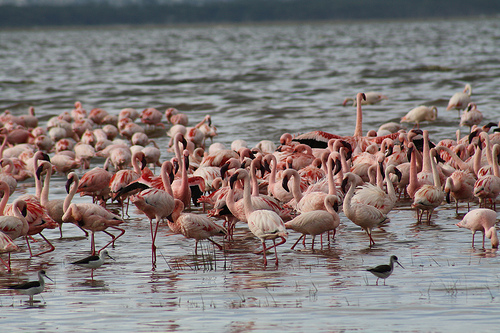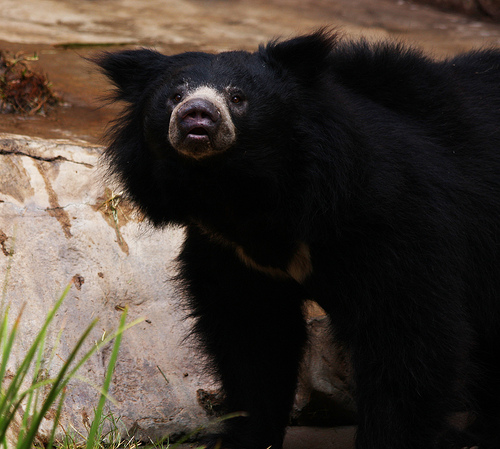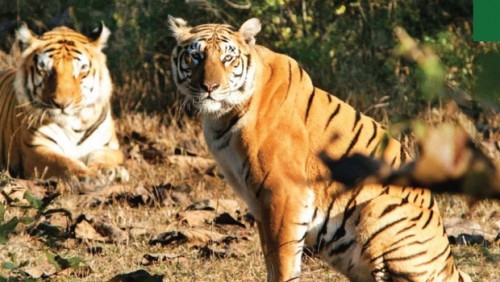RISING NUMBERS: The desert state of India is flocking with pink feathered birds this season. The Asian Waterbird Census (AWC) which was completed on January 16th has noted an increase in the number of Greater Flamingos (Phoenicopterus roseus) and Lesser Flamingos (Phoeniconaias minor) in the state.
The census found 1300 greater flamingos and 1800 lesser flamingos in the wetlands of Gudha Jhapong and Devyani area in Sambhar Lake area of Rajasthan which is the largest natural depression in India. The lesser flamingo is classified as Near Threatened (NT) on the IUCN Red List and both need a safer habitat to survive.
Flamingos are beautiful, long-legged birds with thousands moving, breeding and feeding together. Their unique bills help them feed by plunging their heads into the water upside-down and filtering the water for shrimp, which in turn gives the flamingo its bright pink color. The Greater Flamingo is considerably larger than its cousin, the Lesser. Its neck is longer, the larger bill is less prominently kinked, bit more banana-shaped.
Apart from Flamingos, the survey also noted the presence of winter migratory birds such as Northern Shoveler, Pied Avocet, Common Redshank and Black-winged Stilt which is a local species. Over the last few years the numbers of these species had seen a sharp decline. Hence, their visible presence is significant and a matter of joy, despite the fact that the lake on which they thrive is shrinking.
The survey will help maintaining the status of this wetland habitat of the migratory birds and also keep a record of water birds population, species diversity and migration according to T K Roy, AWC, Delhi state coordinator, a member of the team that conducted the census. He adds it will help in creating conservation awareness and for sustainable protection and conservation of this important wetland.
Shrinking Habitat
The increasing population of flamingos in the wetlands of Rajasthan is a positive news. But to maintain their steady population and make the yearly visit a regularity is it essential that they are provided abundant blue-green and red algae along with small insects and small fish for their sustenance in this season.
But the shrinking water bodies pose a major threat to their basic existence. According to reports, until a few years ago, thousands of flamingos and migratory birds use to visit the lake. Even the trees in the lake acted as breeding ground for the birds.
“The number of trees has, however, declined to almost zero and the various channels of water have also dried up giving in to the increasing population pressure,” an expert said.
The census report also highlighted the sorry plight of the lake. It was found to be lacking on most of the parameters on which it was evaluated. Although the catchment area of the lake is 245km, owing to the poor rainfall in the area, there are only two small water bodies. The remaining areas are all dry.
The group from AWC has suggested that measures be taken by the government to restore water in the lakes for the cause of ecological conservation.
Citing the fact that the quality of water is an important factor in the existence and survival of migratory birds, Mr. Roy said,
“The quality of water is such that it should be conducive for cultivation of vegetation and fish breeding, required by birds.”
About the Asian Waterbird Census
The Asian Waterbird Census is an annual event which takes place across Asia and Australia every January. Thousands of volunteers visit wetlands in their country and count waterbirds, AWC is a part of global waterbird monitoring programme, the International Waterbird Census (IWC), which is coordinated by Wetlands International. There are national coordinators across each country; who may be approached by volunteers and bird-lovers interested in participating in the census.
On the one hand, we have bird-lovers and conservationists taking huge efforts to conserve the migratory birds and provide a suitable environment for their sustained survival and on the other are the so-called “educated” predators who crave for their meat. (Read the full story here on how people are killing flamingos for their meat)
Clearly, a lot needs to be done to sensitize the masses on respecting the diversity of our planet and giving them a chance to exist.
More Related Stories,
Flying Towards Death at Nalsarovar Lake
Road Through Rann may ruin Flamingo Population
A Birder’s Paradise Bharatpur Bird Sanctuary
Image via cc/Flickr by Shankar S







Hello Ramya, good job for the post! Agree that flamingo population is rising and loved the way you have described the same in here. Incidentally, we are all set to visit Rajasthan this summer, hope to catch up with flamingos!